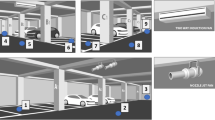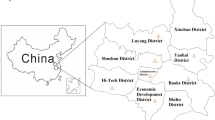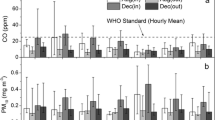Abstract
Most volatile organic compounds are considered potentially harmful air pollutants to the environment and most importantly human health. The present work investigated the concentrations of 72 volatile organic compounds commonly emitted from the vehicular exhausts at a hospital parking garage. The objective was set to assess the associated health risk due to inhalation of these compounds during weekdays versus weekends. Carcinogenic and non-carcinogenic health risks were assessed using the US Environmental Protection Agency conventional approach. A total of 112 air samples were collected inside the hospital parking garage using six-liter evacuated Silonite™-coated polished stainless steel canisters. Triplicate sampling was used for quality assurance/quality control purposes. The air samples were analyzed using the gas chromatography with flame ionization detection system, which followed the US Environmental Protection Agency TO-15 Method. The overall 24-h concentrations of benzene, toluene, ethylbenzene, and xylenes were 6.78, 31.14, 11.35, and 27.85 μg/m3, respectively. These values were comparable to values reported in Europe, North America, and Asia. The weekend concentrations were lower than the weekday ones. Halogenated compounds had the highest contribution of volatile organic compounds groups to total concentrations in both weekday and weekend. The weekday and weekend concentrations temporal cycles were characterized, and they were correlated with the traffic activity inside the parking garage. Two of the measured compounds (i.e., tetrachloromethane and 1,2-dibromoethane) were discovered to pose definite cancer risk. To our knowledge, this is the first study in the region which looks at volatile organic compound levels in a parking garage and the associated health risks.











Similar content being viewed by others
References
Al-Khulaifi NM, Al-Mudhaf HM, Alenezi R, Abu-Shady A-SA, Selim MI (2014) Seasonal and temporal variations in volatile organic compounds in indoor and outdoor air in Al-Jahra City, Kuwait. J Environ Protect 5:310–326
Apel E, Emmons L, Karl T, Flocke F, Hills A, Madronich S, Lee-Taylor J, Fried A, Weibring P, Walega J, Richter D, Tie X, Mauldin L, Campos T, Weinheimer A, Knapp D, Sive B, Kleinman L, Springston S, Zaveri R, Ortega J, Voss P, Blake D, Baker A, Warneke C, Welsh-Bon D, de Gouw J, Zheng J, Zhang R, Rudolph J, Junkermann W, Riemer D (2010) Chemical evolution of volatile organic compounds in the outflow of the Mexico City Metropolitan area. Atmos Chem Phys 10:2353–2376
Araizaga AE, Mancilla Y, Mendoza A (2013) Volatile organic compound emissions from light-duty vehicles in Monterrey, Mexico: a tunnel study. Int J Environ Res 7(2):277–292
Atkinson R (2000) Atmospheric chemistry of VOCs and NOx. Atmos Environ 34:2063–2101
Borbon A, Locoge N, Veillerot M, Galloo JC, Guillermo R (2002) Characterisation of NMHCs in a French urban atmosphere: overview of the main sources. Sci Total Environ 292:177–191
Bouhamra W, BuHamra S, Thomson M (1997) Determination of volatile organic compounds in indoor and ambient air of residences in Kuwait. Environ Int 23:197–204
Chan CY, Chan LY, Wang XM, Liu YM, Lee SC, Zou SC, Sheng GY, Fu JF (2002) Volatile organic compounds in roadside microenvironments of metropolitan Hong Kong. Atmos Environ 36:2039–2047
Esplugues A, Ballester F, Estarlich M, Llop S, Fuentes-Leonart V, Mantilla E, Iñiguez C (2010) Indoor and outdoor air concentrations of BTEX and determinants in a cohort of one-year old children in Valencia, Spain. Sci Total Environ 409:63–69
Gallego E, Roca FX, Guardino X, Rosell MG (2008) Indoor and outdoor BTX levels in Barcelona City metropolitan area and Catalan rural areas. J Environ Sci 20:1063–1069
Graham LA, Belisle SL, Baas C-L (2008) Emissions from light duty gasoline vehicles operating on low blend ethanol gasoline and E85. Atmos Environ 42:4498–4516
Guo H, Lee SC, Louie PKK, Ho KF (2004) Characterization of hydrocarbons, halocarbons and carbonyls in the atmosphere of Hong Kong. Chemosphere 57:1363–1372
Heeb NV, Forss A-M, Bach C (1999) Fast and quantitative measurement of benzene, toluene and C2-benzenes in automotive exhaust during transient engine operation with and without catalytic exhaust gas treatment. Atmos Environ 33:205–215
Heeb NV, Forss A-M, Bach C, Mattrel P (2000) Velocity dependent emission factors of benzene, toluene and C2-benzene of a passenger car equipped with and without a regulated 3-way catalyst. Atmos Environ 34:1123–1137
Heeb NV, Forss A-M, Weilenmann M (2002) Pre-and post-catalyst-, fuel-velocity-and accelation-dependent benzene emission data of gasoline-driven EURO-2 passenger cars and light duty vehicles. Atmos Environ 36:4745–4756
Heeb NV, Forss A-M, Saxer CJ, Weilhelm P (2003) Methane, benzene and alkyl benzene cold start emission data of gasoline-driven passenger cars representing the vehicle technology of the last two decades. Atmos Environ 38:6621–6629
Herrington J, Hays M, George B, Baldauf R (2012) The effects of operating conditions on semivolatile organic compounds emitted from light-duty, gasoline-powered motor vehicles. Atmos Environ 54:53–59
Ho KF, Hang Ho SS, Lee SC, Louie PKK, Cao J, Deng W (2013) Volatile organic compounds in roadside environment of Hong Kong. Aerosol Air Qual Res 13:1331–1347
Hoque RR, Khillare PS, Agarwal T, Shridhar V, Balachandran S (2008) Spatial and temporal variation of BTEX in the urban atmosphere of Delhi, India. Sci Total Environ 392(1):30–40
IPCS (2000) IPCS, International Programme on Chemical Safety. Environmental Health criteria 214: human exposure assessment. World Health Organization, Geneve. http://www.inchem.org/documents/ehc/ehc/ehc214.htm. Accessed June 2017
Kendall P (1993) Outdoor air quality in Toronto: issues and concerns. City of Toronto Department of Public Health, Toronto
Kumar A, Singh BP, Punia M, Singh D, Kumar K, Jain VK (2014) Assessment of indoor air concentrations of VOCs and their associated health risks in the library of Jawaharlal Nehru University, New Delhi. Environ Sci Pollut Res Int 21:2240–2248
Kuntasal ÖO, Kılavuz SA, Karman D, Wang D, Tuncel G (2013) C5–C12 volatile organic compounds at roadside, residential, and background locations in Ankara, Turkey: temporal and spatial variations and sources. J Air Waste Manag Assoc 63:10
Miller G, Fortney P, Lantos T, Thompson M, Pelosi N, Eshoo A, Lee B, Woolsey L (1999). Exposure to hazardous air pollutants in the San Francisco Bay area. http://georgemiller.house.gov/airreport.html. Accessed Jan 2017
Mohamed M, Kang D, Aneja V (2002) Volatile organic compounds in some urban locations in United States. Chemosphere 47:863–882
Ongwandee M, Moonrinta R, Panyametheekul S, Tangbanluekal C, Morrison G (2011) Investigation of volatile organic compounds in office buildings in Bangkok, Thailand: concentrations, sources, and occupant symptoms. Build Environ 46:1512–1522
Pang Y, Fuentes M, Rieger P (2014) Trends in the emissions of volatile organic compounds (VOCs) from light-duty gasoline vehicles tested on chassis dynamometers in Southern California. Atmos Environ 83:127–135
Ramadan A (2017) Quantification of the contribution of the main activities at the Shuaiba West Industrial Area to ambient pollution levels at Ali Sabah Al-Salem (preliminary study), final report. Kuwait Institute for Scientific Research
Ramírez N, Cuadras A, Rovira E, Borrull F, Marcé RM (2012) Chronic risk assessment of exposure to volatile organic compounds in the atmosphere near the largest Mediterranean industrial site. Environ Int 39:200–209
Rappengluck B, Fabian P, Kalabokas P, Viras L, Ziomas I (1998) Quasi-continuous measurements of non-methane hydrocarbons (NMHC) in the greater Athens area during Medcaphot-Trace. Atmos Environ 32:2103–2121
Sarkar C, Kumar V, Sinha V (2013) Massive emissions of carcinogenic benzenoids from paddy residue burning in North India. Curr Sci 104:1703–1709
Schifter I, Magdaleno M, Díaz L, Krüger B, León J, Palmerín ME, Casas R, Melgarejo A, López-Salinas E (2002) Contribution of the gasoline distribution cycle to volatile organic compound emissions in the metropolitan area of Mexico City. J Air Waste Manag Assoc 52:535–541
Schneidemesser E, Monks P, Plass-Duelmer C (2010) Global comparison of VOC and CO observations in urban areas. Atmos Environ 44:5053–5064
Sexton K, Linder SH, Marko D, Bethel H, Lupo PJ (2007) Comparative assessment of air pollution-related health risks in Houston. Environ Health Perspect 115:1388–1393
Sin D, Wong Y, Shama W, Wang D (2001) Development of an analytical technique and stability evaluation of 143 C3–C12 volatile organic compounds in Summa® canisters by gas chromatography–mass spectrometry. Analyst 126:310–321
Son B, Breysse P, Yang W (2003) Volatile organic compounds concentrations in residential indoor and outdoor and its personal exposure in Korea. Environ Int 29:79–85
Staehelin J, Schläpfer K, Bürgin T, Steinemann U, Schneider S, Brunner D, Bäumle M, Meier M, Zahner C, Keiser S, Stahel W, Keller C (1995) Emission factors from road traffic from a tunnel study (Gubristtunnel, Switzerland). Part I: concept and first results. Sci Total Environ 16:141–147
Staehelin J, Keller C, Stahel W, Schläpfer K, Steinemann U, Bürgin T, Schneider S (1997) Modelling emission factors of road traffic from a tunnel study. Environmetrics 8:219–239
Staehelin J, Keller C, Stahel W, Schläpfer K, Wunderli S (1998) Emission factors from road traffic from a tunnel study (Gubristtunnel, Switzerland). Part III: results of organic compounds, SO2 and speciation of organic exhaust emission. Atmos Environ 32(6):999–1009
Tang J, Chan C, Wang X, Chan L, Sheng G, Fu J (2005) Volatile organic compounds in a multi-storey shopping mall in Guangzhou, South China. Atmos Environ 39:7374–7383
Tong L, Liao X, Chen J, Xiao H, Xu L, Zhang F, Niu Z, Yu J (2013) Pollution characteristics of ambient VOCs in the southeast coastal cities of China. Environ Sci Pollut Res 20(4):2603–2615
Touaty M, Bonsang B (2000) Hydrocarbon emissions in a highway tunnel in the Paris area. Atmos Environ 34:985–999
USEPA (1999) Compendium of methods for the determination of toxic organic compounds in ambient air, 2nd edn. USEPA, Cincinnati, Ohio
USEPA (2016) USEPA web. http://www.epa.gov/iris/
Wang J, Ren X, Ji D, Zhang J, Sun J, Wu F (2012) Characterization of volatile organic compounds in the urban area of Beijing from 2000 to 2007. J Environ Sci 24(1):95–101
Wang J, Jin L, Gao J, Shi J, Zhao Y, Liu S, Jin T, Bai Z, Wu C-Y (2013) Investigation of speciated VOC in gasoline vehicular exhaust under ECE and EUDC test cycles. Sci Total Environ 445:110–116
Yurdakul S, Civan M, Tuncel G (2013) Volatile organic compounds in suburban Ankara atmosphere, Turkey: sources and variability. Atmos Res 121:298–311
Acknowledgements
The authors are grateful to the Kuwait University for funding this project (KISR-EC021S). We would like to thank Dr. Anju Muraleedharan for her on the GC-FID analysis of the collected samples. Special thanks are also due to Mr. Joby Jose and Mr. Abhilash Ninmely for collecting the samples.
Author information
Authors and Affiliations
Corresponding author
Additional information
Editorial responsibility: Mohamed Fathy Yassin
Rights and permissions
About this article
Cite this article
Ramadan, A., Yassin, M.F. & Alshammari, B.Z. Health risk assessment associated with volatile organic compounds in a parking garage. Int. J. Environ. Sci. Technol. 16, 2549–2564 (2019). https://doi.org/10.1007/s13762-018-1641-y
Received:
Revised:
Accepted:
Published:
Issue Date:
DOI: https://doi.org/10.1007/s13762-018-1641-y




